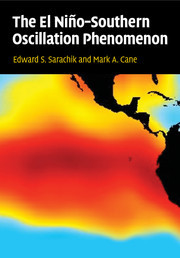The El Niño-Southern Oscillation Phenomenon
Auteurs : Sarachik Edward S., Cane Mark A.

Mark A. Cane is G. Unger Vetlesen Professor of Earth and Climate Sciences, and Director of the Master of Arts Program in Climate and Society at the Lamont Doherty Earth Observatory, Columbia University. With Lamont colleague Steven Zebiak, he devised the first numerical model able to simulate El Niño or Southern Oscillation (ENSO), and in 1985 this model was used to make the first physically based forecasts of ENSO. Since then the Zebiak-Cane model has been the primary tool used by many investigators to enhance understanding of ENSO. Professor Cane continues to work on El Niño prediction and its impact on human activity, especially agriculture and health. His efforts over many years were instrumental in the creation of the International Research Institute for Climate and Society at Columbia. His current research interests include paleoclimate problems and the light they shed on futu
Date de parution : 03-2018
Ouvrage de 383 p.
16.9x24.5 cm
Disponible chez l'éditeur (délai d'approvisionnement : 14 jours).
Prix indicatif 50,94 €
Ajouter au panierDate de parution : 02-2010
Ouvrage de 384 p.
18x25.3 cm
Disponible chez l'éditeur (délai d'approvisionnement : 14 jours).
Prix indicatif 83,43 €
Ajouter au panier


